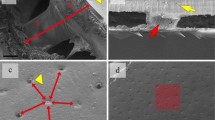Abstract
The mechanical properties and the topological structure of cross-sections found in Cybister elytra are presented. SEM images show the similar geometric structure in transverse and longitudinal sections. Elytra consist of several layers: a dense, black epicuticle, an exocuticle that is braided by several parallel chitin fiber layers in a helix structure, and many bridge piers formed by the fiber bundles that connect the exocuticle to the endodermis, forming a composite, light-weight biomaterial. The mechanical properties along the edge of elytra are measured using a nano-indenter. The hardness and modulus of fresh cybister elytra is 0.31 GPa and 6.13 GPa, respectively. The ultimate stresses of fresh elytra, measured by using a tensile test machine, are 169.2 MPa and 194.5 MPa in the transverse and longitudinal directions, respectively, which is twice higher than that of the dried one. The difference in the two directions indicates that this bio-material has been topologically optimized during evolution. The results may provide a biological template to inspire lightweight structure design for aerospace engineering.
Similar content being viewed by others
References
Dai Z D, Zhang Y F, Liang X C, et al. Coupling between elytra of some beetles: Mechanism, forces and effect of surface texture. Sci China Ser C: Life Sci, 2008, 51: 894–901
Wang L D, Sun W Z, Liang T X, et al. Progress in bionic materials. J Mater Engin, 1996, 17: 3–5
Dai Z D, Wang W Y, Zhang Y F, et al. Applications in outer space Explore about the structure, height, intensity and topology of the beetle’s exoskeleton. In: The Conference of the Outer Space Explore Technology and the Science Subject, 2005, 68–72
Zhang Y C, Hai S W, Zhang J X, et al. Research and observe on the dorsal morphology of Dactylispa angulosa (solsky) under SEM. J Shanxi Normal University (Natural Science Edition), 2001, 29: 70–73
Zhang Y C, Zhang Y, Zheng Z M. Comparision of the ultrastructures in 4 beetles’ elytra. J Northwest Univer (Natural Science Edition), 2001, 31: 522–524
Chen J X, Ni Q Q. Three dimensional composite structures in the fore-wing of beetles. Acta Mater Comp Sin, 2003, 20: 61–66
Chen B, Peng X H, Fan J H. Fiber-reinforced characteristics of chafer cuticle and research on structure of branched fiber. Chin J Mater Res, 2003, 17: 630–636
Cheng H, Sun J R, Ren L Q, et al. Structure of the integumentary surface of the dung beetle Copris ochus Motschulsky and its relation to non-adherence of substrate particles. Acta Entomolo Sin, 2002, 45: 175–181
Holleway B A. Elytra surface structures as indicators of relationships in stag beetles, with reference to the New Zealand species (Coleoptera, Lucanidae). New Zealand J Zoology, 1997, 24: 51–63
Liu F, Yin H W, Dong B Q, et al. Inconspicuous structural coloration in the elytra of beetles Chlorophila obscuripennis (Coleoptera). Phy Rev, 2008, 77: 901–904
Breed R S, Ball E F. The interlocking mechanisms which are found in connection with the elytra of Coleoptera. Biol Bull 1909, 6: 289–303
Gorb S N, Rolf G B, Kastner V, et al. Structural design and biomechanics of friction-based releasable attachment devices in insects. Integrative Comparative Bio, 2002, 42: 1127–1139
Gorb S N, Goodwyn P J. Wing-locking mechanisms in aquatic heteroptera. J Morpho, 2003, 257: 127–146
Goodwyn P J, Gorb S N. Attachment forces of the hemelytra locking mechanisms in aquatic bugs (Heteroptera: Belosto matidae). J In-sect Physio, 2003, 49: 753–764
Yang Z X, Yu Q Q, Dai Z D, et al. Measurements on mechanical parameters and studies on microstructure of elytra in beetles. Acta Mater Compositae Sin, 2007, 24: 92–98
Dai Z D, Zhang Y F, Sun J R, et al. Coupling between elytra of some beetles: Mechanism, forces and effect of surface texture. Sci China Ser C: Life Sci, 2008, 38: 542–549
Yi Q Q, Yang Z X, Dai Z D, et al. Studies on surface textures and mechanical properties of elytra in Cybister. Prog Nat Sci, 2006, 16: 365–369
Chen J X, Ni Q Q, Li Q, et al. Biomimetic light weight composite structure with honeycomb-trabecula. Acta Mate Compo Sin, 2005, 22: 103–108
Shanghai first medical institute. Organise embryology. BeiJing People’s Medical Publishing House, 1979, 39–47
Kurachi M, Takaku Y, Komiya Y, Hariyama T. The origin of extensive colour polymorphism in Plateumaris sericea. Natur wissen schaften, 2002, 89: 295–298
Chen P Y, Albert Y M, Lin, et al. Structure and mechanical properties of crab exoskeletons. Acta Biomater, 2007, 12: 1–10
Sachs C, Fabritius H, Raabe D. Experimental investigation of the elastic-plastic deformation of mineralized lobster cuticle by digital image correlation. J Struct Bio, 2006, 155: 409–425
Author information
Authors and Affiliations
Corresponding author
About this article
Cite this article
Yang, Z., Dai, Z. & Guo, C. Morphology and mechanical properties of Cybister elytra. Chin. Sci. Bull. 55, 771–776 (2010). https://doi.org/10.1007/s11434-009-0363-4
Received:
Accepted:
Published:
Issue Date:
DOI: https://doi.org/10.1007/s11434-009-0363-4




